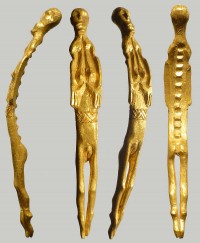 Three metal detector hobbyists scanning a field on the Danish island of Bornholm in early May discovered a stylized gold figurine of a nude woman. She’s a tiny thing, less than 1.7 inches high and weighing only three grams, but her maker managed to cram a great deal of detail in that small space.
Three metal detector hobbyists scanning a field on the Danish island of Bornholm in early May discovered a stylized gold figurine of a nude woman. She’s a tiny thing, less than 1.7 inches high and weighing only three grams, but her maker managed to cram a great deal of detail in that small space.
Her slim body is elongated and gently curved and may have been carved from a solid thin bar of gold. Her face is Modigliani long with a prominent jaw and strong features. Her hair is represented by striations carved into the back of her head and forehead. Her arms stretch down to her waist but just under the shoulders there are indents on both sides that may indicate her arms have been tied to her body. Her fingers point downwards, touching a belt carved in a zig-zag pattern, while her thumbs are outstretched horizontally towards each other, meeting underneath her sagging breasts. Her genitalia are unmistakable between slender, short but remarkably shapely legs with alternating curves of buttocks, knees, calves and elegantly pointed feet. When you look at her from the side, her legs make her seem like she’s jumping or on her tippie-toes.
The detail on her back is of particular interest because it’s never been seen before. The concave sway of her back is decorated with what archaeologists are calling “teeth.” They look more like steps to me. Since this is the first example of this design discovered, its significance is unclear.
Other gold figurines have been found in this field before. The first was found in 2009. She’s the fifth and the only female.
The five figurines were probably buried in the same place, individually or collectively, at some point during the 6th century AD, i.e. the Migration Period.
Three of them were found within five metres of each other, while the other two were found 10-15 metres further away. Presumably it was the plough that separated them.
This location may have been chosen due to the presence of one or more springs.
 Other artifacts, including figures made from cut and engraved gold sheets, have been found on the field. Believe it or not, the area has not yet been systematically excavated by archaeologists despite the very shiny incentive and the prospect of discovering more about a period that has very little in the way of documentary sources. Plans are in the works to rectify this.
Other artifacts, including figures made from cut and engraved gold sheets, have been found on the field. Believe it or not, the area has not yet been systematically excavated by archaeologists despite the very shiny incentive and the prospect of discovering more about a period that has very little in the way of documentary sources. Plans are in the works to rectify this.
Meanwhile, the four gold men and one gold woman are on display along with other treasures from Smørenge field at the Bornholm Museum.
The first thing that struck my mind is that it was part of a decorative hair clip. That might explain the “teeth”, and lack of any other decoration, on her back.
I agree–the curved shaped instantly made me think of a hair ornament.
Who owns the figurine? Does the Danish government compensate the finders or the landowners?
It seems like a clever adaptation of the spine to help the device serve as a hair clip. The “tied” arms could function as a connecting point for the back piece — perhaps something organic which has long decomposed.
I wondered if she might turn up on The History Blog! When I ran across photos of her I also was thinking the spine details looked like those of a modern barrette. It’s interesting that the similarity is being seen by many of us! I suppose it’s a distinctive design element that one rarely sees on other items.
Oops, that was me commenting 🙂 Also, the lack of other anatomical details (arms, buttocks) on the back of the figure suggest that this side was not meant to be on display.
wikipedia –> Gullgubber
“The word gullgubbe means “little old man of gold” and is taken from a report published in 1791 by Nils Henrik Sjöborg, in which he said that villagers in Ravlunda, Scania who found them in the dunes called them guldgubbar.
Approximately 3,000 gullgubber have been found, from approximately 30 sites in Norway, Sweden, and the greatest number in Denmark. No fewer than 2,350 were found at the settlement of Sorte Muld on the Danish island of Bornholm, while over 100 were found at Lundeborg, near Gudme on the Danish island of Funen, and most recently 122 at Uppåkra, Scania, Sweden.”
I too vote for hair clip to hold a braid or ponytail. Similar to some bracelet clasps I envision a cord looped around the head/neck with a small bar at the other end brought around to encircle the hair. The bar would slip into the slot between the legs then be turned perpendicular to hold.
Its luster and brilliance made it easy to find, and as early man discovered that it was also easy to work with and wouldn’t tarnish or corrode, it became the first metal to be used by humans. Since gold is found throughout the world, nearly every civilization has record of it in early history.
Having done lost wax casting for a great many years I suspect that upon careful inspection you will find that the man and woman are created first out of wax and then cast in gold. Not “carved” out of gold.